#croulebarbe
Explore tagged Tumblr posts
Photo
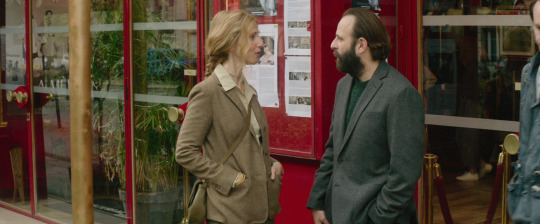

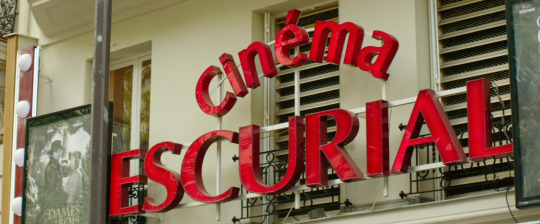
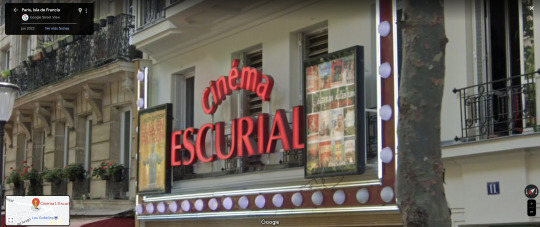
Chronique d'une liaison passagère / Diary of a Fleeting Affair Emmanuel Mouret. 2022
Cinema 11 Bd de Port-Royal, 75013 Paris, France See in map
See in imdb
#emmanuel mouret#chronique d'une liaison passagère#diary of a fleeting affair#sandrine kiberlain#vincent macaigne#cinema#croulebarbe#paris#france#salpêtrière#movie#film#location#google maps#street view#2022
17 notes
·
View notes
Text
Les Mis Canon-era Photos Part 1: The Gorbeau House
In the late 19th century huge chunks of Paris were torn down and rebuilt, in a series of construction projects referred to as “The Haussman Renovations.” So the Paris streets we see in Les Mis often don’t resemble the Paris streets of today….except! Shortly before/during the renovations, a photographer named Charles Marville took a series of photographs of the old city. While he took them thirty years after the events of the story (in 1860) it’s still fascinating to see older Parisian architecture.
The Les Mis readalong just made it to the Gorbeau Hovel, the small hovel where Jean Valjean and Cosette live right after they live the Thenardier’s inn. Hugo tells us the Gorbeau house is located in "the Old quarter of the Marché-aux-Chevaux,” an area that is poor and isolated. Here are Marville’s photographs labeled Marché-aux-Chevaux:
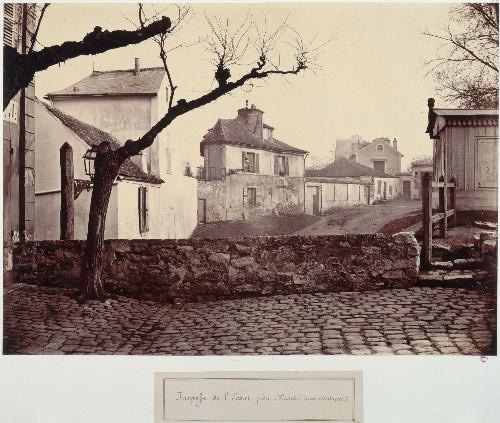
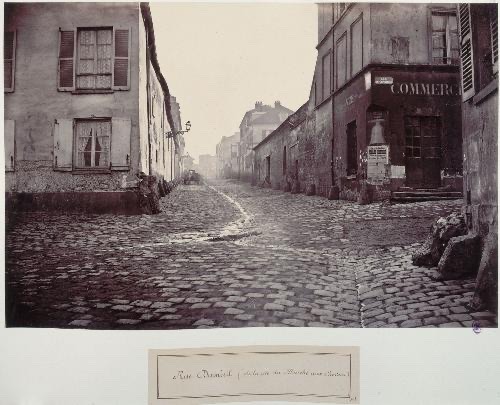
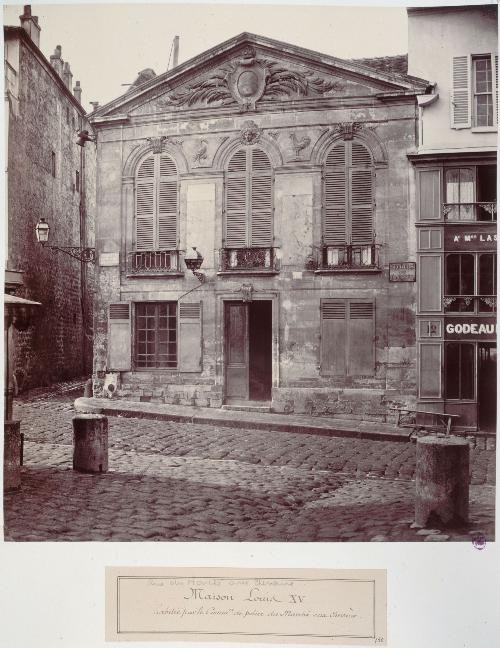



Marville does not have photographs of many of the specific streets Hugo mentions in this chapter. One street he does have, though. Hugo says “Take a few steps, and you come upon that fatal Rue Croulebarbe, where Ulbach stabbed the goat-girl of Ivry to the sound of thunder, as in the melodramas." Marville does have a photograph of the Rue Croulebarbe!

For additional photo reference:
This is not a Marville photograph. But the 1925 silent film adaptation of Les Mis, directed by Henri Fescourt, features a Gorbeau house set that is extremely similar to its depiction in the novel:
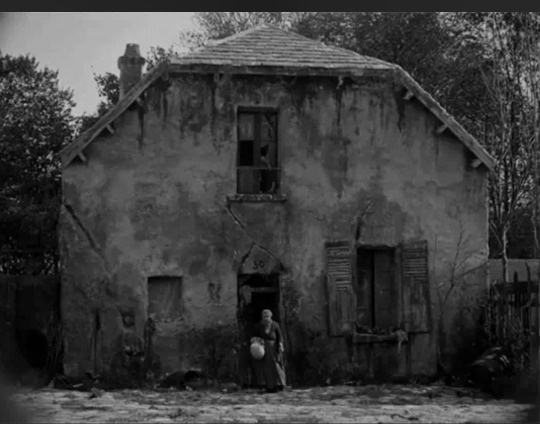
150 notes
·
View notes
Text


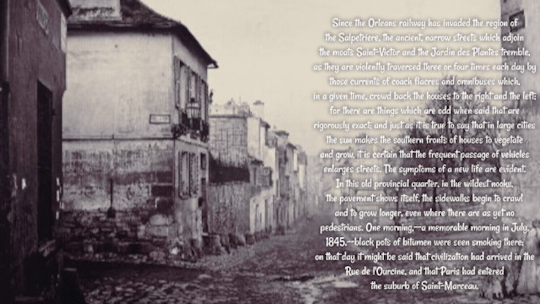
The Change of Marché-aux-Chevaux and Rue Croulebarbe. Volume 2, Book 4, Chapter 1.
Pictures from @secretmellowblog's Original Post.
#Les miserables#les mis#My Post#Gorbeau House#Paris#Thanks to secretmellowblog!#The Brick#Historical Pictures#Les Mis Letters
17 notes
·
View notes
Text

La rue Croulebarbe photographiée par Henri Godefroy avant le recouvrement de la Bièvre, Paris XIIIe, 1905.
0 notes
Photo

23 lettres à un inconnu • action poétique urbaine • levée d’écrou #art #contemporaryart #lettres #letters #letterslive #workinprogress #afterquarantine #gherasimluca #croulebarbe #paris #13arrondissementstreetart #ephemeralart #artinparis (à Quartier de Croulebarbe) https://www.instagram.com/p/CBARhCVqyKP/?igshid=qhwy5h7h46p3
#art#contemporaryart#lettres#letters#letterslive#workinprogress#afterquarantine#gherasimluca#croulebarbe#paris#13arrondissementstreetart#ephemeralart#artinparis
0 notes
Photo

Rue de la Glacière
2 notes
·
View notes
Photo

Édouard Albert, Robert Boileau, Jacques-Henri Labourdette – Tour Croulebarbe (Paris, 1960)
Premier gratte-ciel parisien
#édouard albert#robert boileau#jacques-henri labourdette#tour croulebarbe#skyscraper#early skyscraper#1960s architecture#parisian architecture#french architecture#modern architecture#architecture
12 notes
·
View notes
Text


Located in the 13th district of Paris, rue Croulebarbe, the Albert tower was built by Édouard Albert in the late 1960s. First skyscraper housing the capital, it is listed as a Historical Monument since 1994.
38 notes
·
View notes
Note
Hi Jackie long time appreciator of your blog. Thank you in particular for posting on Alejandra Pizarnik and Amelia Rosselli, who I discovered thru you – those exceptional mid-century metabolisers of misogyny, and as poets so much more.
Seeing your latest post on Lacan I was reminded of this brilliant interview with Chantal Akerman, perhaps you've read, where she recalls:
Later, I lived on the rue Croulebarbe, in the same building as François and Noëlle Châtelet. With Alex, a young man who was studying Chinese and Laozi, I’d go to Vincennes to listen to Deleuze and Lacan. Lacan was really sarcastic, especially with the girls; he’d take up their questions to mock and ridicule them. He was already into his Borromean knots, and nobody understood any of it. Deleuze, I only saw him one time, I don’t remember it well but I remember the atmosphere: lively, impassioned, fun.
....
NB: In your maid’s chambers, what did you write?
CA: I wrote je tu il elle, but as a novel, not a film. It was only years later [1974] that I made the film.
Full interview here: http://www.lolajournal.com/2/pajama.html
All best,
Mag
Thank you for this. Chantal Akerman knows what’s up. Somehow I was not surprised that Jacques Lacan’s daughter Sibylle committed suicide. (She wrote a memoir about Jacques titled A Father, which I have not read yet.)
Alejandra Pizarnik and Amelia Rosselli—they are sacred to me. I hope my Italian is one day good enough to read Rosselli in the original.
A humble request to anyone out there who translates Spanish to English: can someone please translate Alejandra Pizarnik’s journals??? I’ve desperately wanted to read them for so long. My dear friend was asked to translate them into French and said she couldn’t do it because they were so dark she might lose her mind while translating them. I was really surprised by how much my New School students adored her when I assigned her in my Lost Grrrls class.
#literature#poetry#alejandra pizarnik#amelia rosselli#lacan#chantal akerman#jacques lacan#madness#feminism
12 notes
·
View notes
Text
Brickclub 4.2.4 ‘An apparition to Marius’
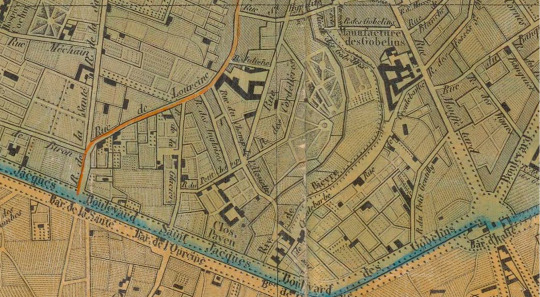
I’m not managing to pinpoint exactly where Marius is sitting, but it’s around here. This is what at the time was the southernmost corner of Paris, close to the Barriere d’Italie. The Rue de Croulebarbe runs up the middle of this image, and the Rue du Champ du Allouette runs north-ish to the west of it. The Rue de la Santé, though, also runs north, off to the west of both of them. I’m not sure exactly where he is, though, because Santé doesn’t intersect with the others. The Gobelins factory, which made tapestries and furnishings, is up at the top, along with the Bièvre river it was built on, which must be near the smaller stream Marius is sitting by.
He heard behind and below him, on both banks of the stream, the washerwomen of the Gobelins beating their linen; and over his head, the birds chattering and singing in the elms. On the one hand the sound of liberty, of happy unconcern, of winged leisure; on the other, the sound of labour. A thing which made him muse profoundly, and almost reflect, these two joyous sounds.
Two joyous sounds. Jeez.
This is Bad. Champmathieu’s daughter was a washerwoman who died young. Hugo isn’t letting us off with not knowing what this job was like:
“Then I had my daughter, who was a washerwoman at the river. She earned a little for herself; between us two, we got on; she had hard work too. All day long up to the waist in a tub, in rain, in snow, with wind that cuts your face when it freezes, it is all the same, the washing must be done; there are folks who haven't much linen and are waiting for it; if you don't wash you lose your customers. The planks are not well matched, and the water falls on you everywhere. You get your clothes wet through and through; that strikes in. She washed too in the laundry of the Enfants-Rouges, where the water comes in through pipes. There you are not in the tub. You wash before you under the pipe, and rinse behind you in the trough. This is under cover, and you are not so cold. But there is a hot lye that is terrible and ruins your eyes. She would come home at seven o'clock at night, and go to bed right away, she was so tired. Her husband used to beat her. She is dead.”
Marius continues to profoundly miss the point.
Anyway, he’s caught between the goblin and the lark, not that he’s paying any attention to the goblin.
Hugo does a nice job making his brain-state clear. Marius sits down to work every day, and nothing is connecting in his head, and he can’t make it happen. It’s sad and frustrating that his depression compounds his usual lack observation skills to make him even less able to perceive Eponine. But it’s understandable.
Poor Eponine. Hugo is being weird about her having become more beautiful, but I’m going to give him a tentative pass for now. There’s a decent chance this is about this book’s usage of beauty as internal illumination rather than outward appearance, and he’s alluding at least partially to the moral transformation she’s been undergoing.
“She had, in addition to her former expression, that mixture of fear and sorrow which the experience of a prison adds to misery.”
With Brujon, going to prison was just another Thursday, but we haven’t left behind the world Jean Valjean came from, where going to prison changes a person in permanent and terrible ways. Eponine has been changed that way.
Marius is overjoyed at the news that he can see Cosette, because of course he is.
His plot isn’t happening the way plots are “supposed” to happen--character wants something, character takes steps to go and get it, complications ensue--and I think that’s on purpose. Marius is missing all the things that matter, and failing to take the actions that would make a difference. He’s squeaking by largely on the advantages birth and chance gave him--social class, manners, education, good looks, absolutely magical friends, etc--and that’s enough to get him the girl and the happy ending.
I’m not blaming him--his mental illness isn’t his fault. But he’s an unsatisfying character to follow because he’s meant to be. He keeps missing all the things this book stands for, and which the reader in his stead is being strongly encouraged not to miss in their own life.
And Eponine is experiencing the moral reckoning and burgeoning agency that seems structurally like it should have been his. She’s lied for him, she’s made moral judgments for the first time in her life, she’s noticed people in pain and been kind.
And this chapter, she’s weighing being selfless to someone she cares about because he’s sad and she wants to make him happy, even though it will lose her any chance at the thing she most wants.
And she does it. But even when she’s being selfless, she asserts her own dignity. She draws the line between their social classes herself, rather than seeing how much he will and won’t give her, and she refuses to let him make this exchange into something she did for money.
ETA: GOD, I just noticed that Gillenormand’s rooms are decorated in Gobelins tapestries. I don’t know, I can’t quite lay out the metaphor succinctly, but it feels important. There’s such a stark divide here with Marius benefiting from Eponine’s goblin status and from hers and other people’s labor, and he doesn’t even notice that there *was* sacrifice or labor.
15 notes
·
View notes
Photo

France - Street art on rue Croulebarbe in Paris.
10 notes
·
View notes
Photo

France - Street art on rue Croulebarbe in Paris.
3 notes
·
View notes
Text
Chronique des chemins et même des détours

Le chemin date de la plus haute Antiquité. Déjà Nicéphore l’Atrabilaire le chante dans ses œuvres complètes. Et Zénobe V, dit le Scrofuleux, lui consacre d’inoubliables alexandrins dans son panégyrique sur les sentiers des bœufs. C’est dire combien le chemin est ancien. Les savants les plus chauves en situent même l’origine dans la préhistoire. Ils estiment que l’homme des cavernes ne sortait de son trou que pour assouvir sa faim et sa soif. Sitôt celles-ci apaisées, il y rentrait pour échapper au léopard d’Afrique et au tigre de Bengale. Ses allers-retours se faisant par le chemin le plus court et dans les plus brefs délais, il en résultait d’abord une trace, puis une piste, enfin un sentier. Ce n’était encore qu’un chemin en puissance. Mais déjà le boulevard et l’autoroute se profilaient à l’horizon. Où l’on voit que l’homme ne trouva sa voie que chemin faisant.
Cette chronique ne se lassant pas de célébrer les bienfaits de l’humanité, je chanterai donc la route, la piste cyclable et même la chaussée empierrée. Car que ferait l’homme sans elles ? Il se perdrait dans l’immensité des steppes et des plaines. Il tournerait en rond, en zigzag, sinon en crabe. Il aurait la démarche hésitante de l’âne de Turquie et de l’Auvergnat après la bourrée. Sa trace serait semblable à une lettre arabe ou chinoise, voire à une peinture abstraite de grand prix. Sans le chemin Jésus n’eût pu faire son chemin de croix. Ni l’apôtre Paul celui de Damas. Quant au chemin de Compostelle, qui fait toujours foi, le pèlerin l’aurait perdu dans les estives des Pyrénées. Au lieu qu’avec le chemin, l’homme sait où il va. Et il y va tout droit en suivant lacets et virages. C’est grâce au chemin qu’il était là-bas tout à l’heure, qu’il est ici maintenant et qu’il arrivera bientôt à destination.
On voit par là à quel point la route est utile aux déplacements de l’homme. Par un penchant inné, elle suit fidèlement les panneaux indicateurs et les bornes kilométriques. Le même scrupule la pousse à emprunter les ponts pour traverser les cours d’eau, au lieu de s’abîmer dans les flots, comme jadis Pharaon avec son armée dans la Mer rouge. Une prudence ancestrale l’incline à rester sagement entre les rangées de maisons ou les allées de platanes qui la bordent. La nature l’a même conçue telle, qu’elle attend patiemment le carrefour pour croiser une route perpendiculaire.
Mais l’utilité des chemins se prouve surtout par la vie citadine. Que serait en effet une ville sans ses avenues, ses périphériques et ses voies pénétrantes ? L’imagine-t-on sans culs-de sac ou voies sans issue ? Avouons que privée de ses sens uniques et de ses accidents d’automobiles, elle perdrait beaucoup de son charme. Vue du haut de la Tour Eiffel, Paris ressemblerait à un immense pâté de sable écrasé par un mastodonte. Le pharmacien ou le marchand de couleurs n’habiteraient plus au coin de la rue Croulebarbe. Le Parisien ne pourrait plus changer de trottoir pour éviter le voisin importun. Résumons-nous, l’arrêt de l’autobus 29 serait relégué au diable vauvert.
Célébrons donc le chemin mais pas n’importe lequel. On se souvient du provincial qui s’était perdu dans la capitale et demandait à un passant le chemin de la gare. « C’est la première à gauche, lui dit cet homme aimable. Mais vous pouvez gagner dix minutes en prenant par l’intérieur. » « Dix minutes, répondit le provincial ? Et qu’en ferais-je ? » On voit par là tout l’intérêt qu’il y a à perdre son temps en choisissant le chemin le plus long. À flâner, à lambiner, à amuser le terrain. Rien n’est en effet plus beau que le détour. C’est le chemin le plus sûr pour découvrir l’insolite. Jacqueline de Romilly, qui connaissait son Odyssée par cœur, vantait souvent les périples du rusé Ulysse. En évoquant l’enseignement en détresse, elle ajoutait qu’il n’y a pas d’apprentissage fécond, ni de culture durable, sans le détour. Et elle avait mille fois raison. Laissons donc le raccourci au touriste pressé ! Préférons le chemin sinueux qui invite à l’étonnement, puis au ravissement. Qui vous expose au paysage inconnu comme à mille détails incongrus. Et concluons sur ce paradoxe : parmi tous les chemins à fouler, il n’y a que le détour qui vaut le détour.
Et c’est ainsi qu’Allah est grand.
#Alexandre Vialatte#Jacqueline de Romilly#Paris#rue Croulebarbe#Pharaon#Tour Eiffel#Jésus#apôtre Paul#Dams#Compostelle
5 notes
·
View notes
Text

BRASSAÏ (1899–1984)
Lovers, rue Croulebarbe, near Place d'Italie, c. 1932
0 notes

